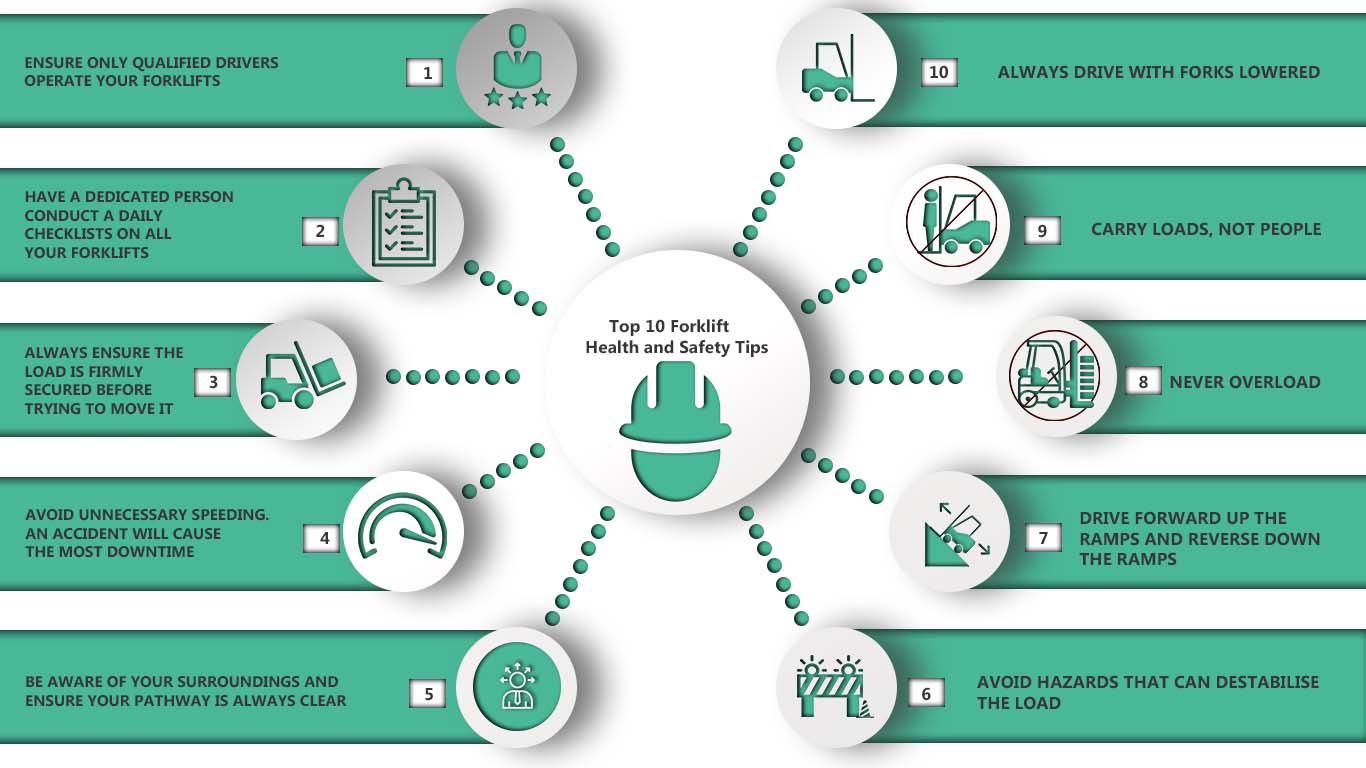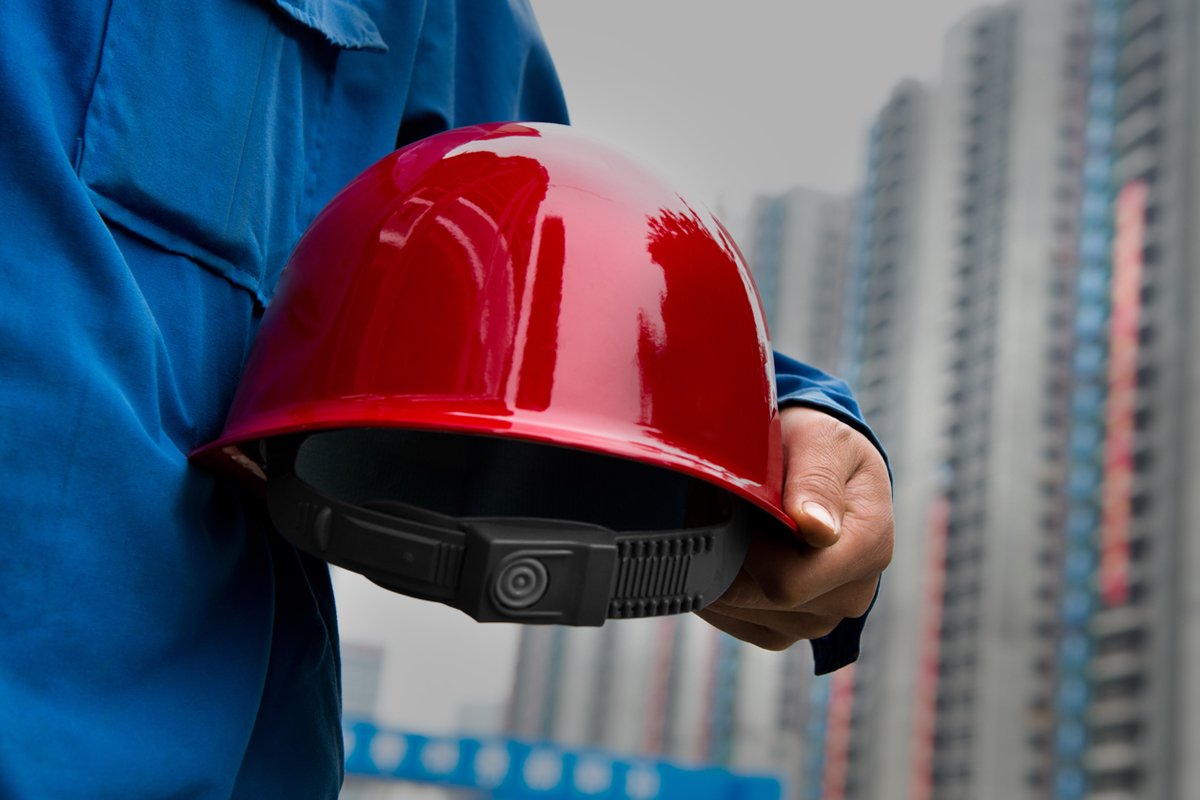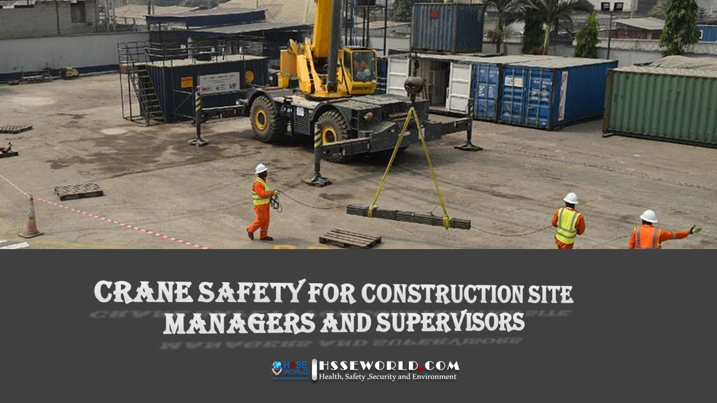Different Work Places have Many and Different hazards with high probability of occurrence if there is no proper control measure to avoid such hazards. It could be affect negatively on workers , equipment and Environment with undesired consequence of Ill health , death or property damage so that HSSE world summarized below 66 Safety Tips shall be taken in different workplaces and activities for example Construction , Driving, electrical , Ergonomics, forklift ,restaurant etc.

General
1
Running propane- or other fuel-powered equipment indoors can cause deadly amounts of carbon monoxide to build up quickly inside rooms and other enclosed work areas.Exposure symptoms may not be detected until it’s too late.
2Don’t eat, drink, or store food and beverages around hazardous chemicals. This helps ensure that contamination doesn’t happen. | |
3Don’t use compressed air to blow dust off equipment or other work surfaces. Dust levels in the air can quickly reach dangerous levels that can pose a health hazard to coworkers and, if combustible, may even explode when it contacts lights or other commonplace electrical sources. | |
4Stay alert for possible hazards during each task you perform, particularly during the final stages of a job. Don’t let familiarity with the job site dull your hazard radar. | |
5Prevent injuries when using cutting tools to open boxes. Always cut away from yourself and immediately sheath the blade if you stop using the tool, even for a short period of time. | |
6Do not use flexible cords that are frayed or have damaged plugs. Take them out of service by placing a tag on them that visibly says, “Damaged, Do Not Use” and report them for replacement (if needed). | |
7Be aware that unusually warm or hot outlets may be a sign of unsafe wiring. Unplug any cords to the outlet, mark the outlet as “Don’t Use”, and report the condition to someone who can safely follow-up. | |
8Don’t store boxes or other items in front of circuit breakers, fuse boxes, or other electrical panels. | |
9Never break off the 3rd prong (ground pin) on a plug or use a flexible cord that’s missing the 3rd prong. | |
10When thinking about trimming trees around power lines remember that electricity loves metal and moisture. Even if you are using a wood ladder around power lines and the ladder is wet or can get wet, you may still be at risk for electrocution. Likewise, if you are pruning a wet tree limb while standing on the ground, and the limb contacts the power line, electricity can travel through the limb, your pruning tool, and you. | |
11Maintain a 35-foot clearance from downed power lines because they may still be energized. | |
12When providing first aid, have the injured person handle their injury, if possible, to protect you from exposure. For example, if a wound needs pressure applied, have the injured person apply the pressure. | |
13Follow safety practices for the sake of your family and co-worker’s if you don’t want to follow safety practices for your own sake. | |
14Never operate a piece of machinery until you have been trained on it and fully understand the safety procedures, including what to do in an emergency. | |
15Make sure all machine safety guards are in place at all times so that moving parts aren’t a danger to you and others working nearby. | |
16If machine safety guards are removed due to maintenance activities, follow company energy control policies so that no one can get hurt due to accidental start up of the machine. When maintenance is finished, replace all the safety guards. | |
17To prevent stumbles and collisions, don’t use cell phones or text while walking up and down stairs or through hallways. | |
| 18 Wear shoes with non-slip soles when walking on icy or slushy roads. Avoid plastic and leather soles. Strap on non-slip shoe treads or cables for more traction. | |
19If the ground is icy, take short steps with slightly bent knees, shuffle your feet, and keep your hands and arms free for better balance if you start to slide. | |
20Don’t let a spill ruin your, or your coworker’s, day. Safely clean up spills right away or mark the area to warn others and report the spill to your supervisor. | |
21Maintain good housekeeping. Keep walkways clear of electrical cords, hoses, and other obstacles so you and co-workers don’t trip or fall. | |
| |
22If you wear hearing protection and can’t hear back up alarms or other important signals, talk to your supervisor to make sure you get the correct type of hearing protection. More protection is not always better. | |
23Stretch out your arms, legs, wrists and back when you have time. The repeated motion some construction tasks can create problems such as muscle cramps or even carpal tunnel syndrome in your wrists and forearms. Stretching will help to keep your muscles loose and prevent cramps and other problems. | |
24Check the tool manual to make sure the air pressure setting is right for the size and type of nail you are using. Too much pressure can cause a nail to pass through the material to injure others nearby. | |
25Always handle pneumatic nailing or stapling tools as if they are fully loaded. Don’t transport or load the tool with your finger on the trigger. Don’t squeeze the trigger unless the nosepiece is directed at a safe work surface. | |
26Make sure subcontractors know how to find, use, and properly store safety gear at shared job sites. | |
27Do not leave equipment lying around that can cause a tripping hazard at the job site. | |
| |
28Before driving a vehicle, minimize blind spots by adjusting the left- and right-side mirrors until you can see the tip of the rear bumper in the lower inside corner of each mirror. | |
29No need to speed. Plan ahead so you leave yourself plenty of time for safe travel. | |
30Get in the habit of turning on your headlights when you turn on your windshield wipers for driving in the rain. This will help make your vehicle more visible to others. | |
31When parking, drive into a pull-through parking spot (if available), to eliminate the need for backing. | |
32Don’t race for a parking space. Follow parking lot speed limits or, if no limit is posted, slow down anyway to allow safer reaction to unexpected occurrences. | |
33Don’t cut diagonally across parking lots. Drive in designated traffic lanes and directions. | |
34Turn off radios and other electronic devices to prevent distraction when driving in parking lots. This will help you stay fully alert for pedestrians, bicycles, light posts, and other vehicles, especially in icy or snowy parking lots. | |
35Don’t pump the brakes if your car has an anti-lock brake system (ABS) because pumping will disengage the anti-lock system. When the ABS is activated, it automatically pumps the breaks for you so don’t be alarmed if you feel pedal pulsations or vibration. Always “brake and steer” when using four-wheel ABS. | |
36Don’t slam on the brakes if you have a blowout on the highway. Take your foot off the gas pedal to let the car slow down gradually and steer your vehicle toward an exit, the shoulder, or other safe location (using directional signals, if needed). | |
37Stay clear of snow drifts in parking lots that can prevent drivers from seeing you (and vice versa). Don’t take short cuts over drifts or piles of plowed snow. | |
38Be seen-be safe. Wear a high-visibility vest each time you exit your truck in the company yard, at your customer’s dock, and on the side of the road. | |
| |
39When using power equipment in wet places, make sure the outlets have a GFI, system. | |
| |
40Break up repetitive work with non-repetitive tasks to give your muscles a rest. | |
41Keep objects close to you as you lift and carry them, even if they aren’t very heavy. If an object is away from your body when you lift it, your back muscles will have to work harder and you’ll have more stress on your spine. | |
42Never twist your body when lifting items since this increases stressful forces on the back. Instead, pick up your feet and step into the right direction. | |
43If you have to move a heavy item manually, store it at a safe height. Waist level is ideal, but somewhere between knee and should height may be acceptable. If you can, slide the item onto a cart instead of lifting and carrying it. These actions can help prevent back, shoulder, and other musculoskeletal injuries. | |
44When shoveling snow, use the shovel blade to push the snow like a plow as much as possible (so you don’t have to lift and dump snow). If you must lift and dump snow, keep your back straight and bend knees to create the shoveling motion and keep the load close to you as you lift and dump it. Move your feet so you won’t need to twist your body around. | |
45Push, don’t pull. Pushing allows you to use your body weight and larger muscles to move a load. | |
46Don’t lift boxes or other items located below knee level when sitting in your chair. Crouch down so that you can use your leg muscles to lift the item up to a waist level. | |
| |
47Secure pallet loads with shrink-wrap or other strapping material to reduce the chance of being struck by items that may shift or fall off during transport. | |
48Keep forklifts from tipping over. Drive with the load in it’s lowest position and use extra caution when making sharp turns or approaching ramps and other uneven or sloping surfaces. Use the seatbelt and don’t raise or lower the forks while moving. | |
49Make sure your wear your seat belt while driving a forklift. If the forklift begins to tip, don’t attempt to jump clear. Hold on tightly to the steering wheel, brace yourself against the seat, and keep your body inside the frame of the machine and lean in the opposite direction of overturn. | |
50Terrain affects forklift balance and handling; for example, even a pothole can be a tip-over hazard in some circumstances. | |
51Make sure all employees know that only trained operators can use forklifts | |
| |
52Label ladders with cracked rungs or other defects and remove them from the work site so someone else doesn’t use them and get hurt. | |
53Always face the ladder when climbing and grip the rungs – not the side rails. Keep three points of contact on the ladder whether two hands and one foot, or two feet and one hand. Never carry materials while climbing. | |
54When climbing, keep your hips between the side rails and do not lean too far or overreach. Instead, reposition the ladder closer to the work. | |
55Step ladders should never be used folded up and leaning against a surface. | |
56Make sure the step ladder is fully open with the spreader bars down and locked in place (to provide the “4 to 1” safety ratio) before climbing. This will prevent the ladder from collapsing. | |
57Choose a step ladder that is tall enough so you aren’t tempted to stand on the top cap or top step. Never use a step ladder to gain access to another working level. | |
58Don’t stand on the back side of typical step ladders since this can cause the ladder to tip over. | |
59Metal extension ladders conduct electricity. Keep them away from power lines. | |
60Before climbing ladders, check for stability. Make sure the ladder is level and the base can’t slide. Check shoes and rungs for grease or mud to minimize possible slipping. | |
61Let someone know when you are going to do ladder work. Do not climb ladders when there’s no one around to get help from in case of an accident. | |
| |
62Get training on safe work practices before using powered equipment or machinery. You should know what problems to look out for and what to do if equipment looks unsafe. | |
| |
63If oil in a pan catches fire during food preparation, don’t pick up the burning pan to carry it away or use water to try to put the fire out. Safely turn off the gas or power and cover the pan with a safety blanket or damp cloth (or use foam or powder fire extinguisher if you have been trained to do so). | |
64Avoid standing in front of swinging doors and doorways. | |
65When using deep fat fryers, reduce spattering by making sure utensils and food are dry before you slowly lower them into the hot oil. Immediately clean up any drips or spills so you and your coworkers don’t slip and fall later. | |
66Cleaning deep-fat fryers can put you at risk for slips and serious burns. Don’t move or strain hot oil; wait till it cools! Use non-slip mats, no-skid floor waxes, and wear shoes with slip resistant soles. | |



